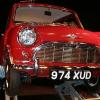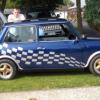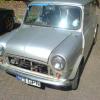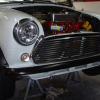
Prep For Spray Tech Questions
#1

Posted 19 May 2014 - 01:55 PM
Thanks
#2

Posted 19 May 2014 - 02:00 PM
Edited by cal844, 19 May 2014 - 02:01 PM.
#3

Posted 19 May 2014 - 02:29 PM
#4

Posted 19 May 2014 - 02:30 PM
#5

Posted 19 May 2014 - 02:43 PM
Ideally you want to finish existing paint with 800 before a new top coat or 400 will be fine before spraying on a primer and make sure that you spot prime any repairs.
If the original paint is sound and without blemishes, then it can be prepped using a scotch brite and some prep and blend paste which makes really light work of it and gives even flatness to the paint without leaving scratches or swirls.
Ben
#6

Posted 19 May 2014 - 03:12 PM
#7

Posted 19 May 2014 - 03:36 PM
Yes, a scotch brite with prep and blend paste will simply 'key' the existing paintwork ready for the fresh topcoat.
800 grit paper is also good for flatting the paintwork but be careful you don't leave behind finger marks in places where it is unsuitable to use a block. 800 is also great for flatting back any scratches but just make sure you feather any edges out so they don't show through to fresh paint.
As i said 400 grit is ideal to prep an area for primer followed by flatting down the primer once it has fully cured with 800.
If you are painting over the original sound paintwork then just make sure you apply primer over any repairs or bare metal areas. This is called spot priming.
Ben
Edited by Ben_O, 19 May 2014 - 03:37 PM.
#8

Posted 19 May 2014 - 04:59 PM
I flatted original paint with p320 abranet dry almost to bare metal to find out what was under it, filler repairs I used p80, followed by p120, followed by p240, then I painted whole car in 2k high build primer. I used a guide coat and sanded this with p320 abranet, used stopper where required then another guide coat and used p400 abranet, then I just applied 2k direct gloss and had no issues with anything showing through, don't forget dry sanding is roughly half the number compared to wet. I found using high build on whole car made it much easier to find blemishes I wouldn't have found if just painting over original paint.
The top coat I have flatted with p1500 to remove dust nibs and any peel, then used abralon p2000 followed by p4000 wet then compound with menzerna polish on a white g mop.
Biggest problems I have had has been dust in the garage then finding out which products to remove the nibs without damaging the paint.
#9

Posted 19 May 2014 - 08:38 PM
Had to use the angle grinder with a layered pad to get rid off a few bits of rust,them areas I'm smoothing out starting at 120 grit as I was gentle with the angle grinder so not to scar the panels.
Cheers for the help
#10

Posted 21 May 2014 - 07:46 PM
1 user(s) are reading this topic
0 members, 1 guests, 0 anonymous users















